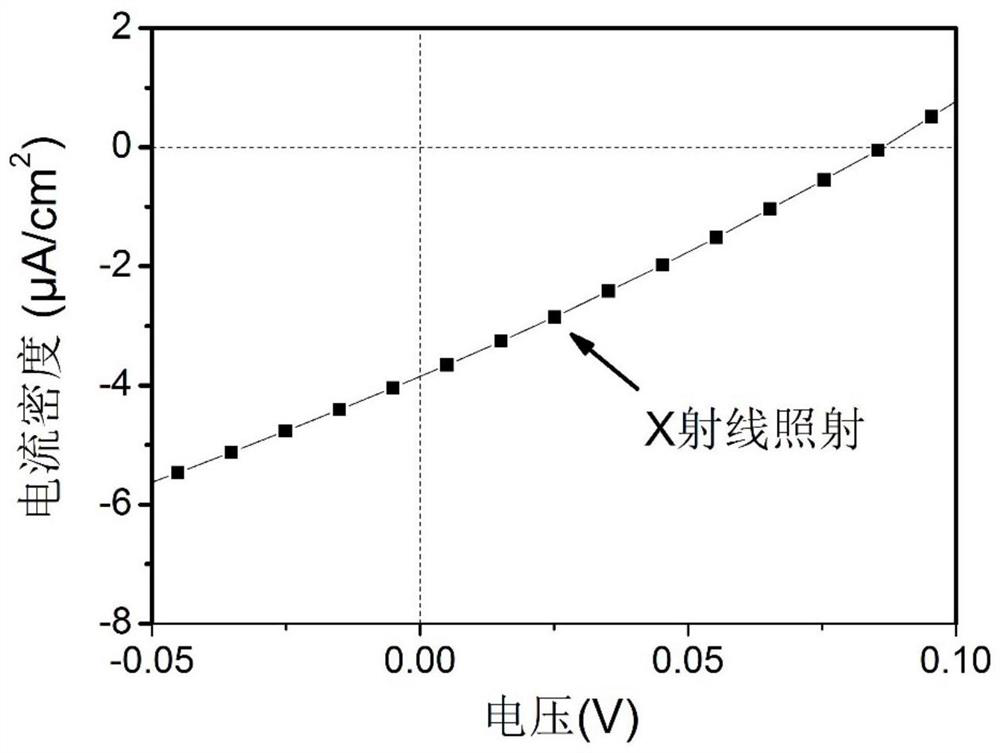A kind of x-ray detector based on nano-carbon material/silicon heterojunction and its preparation method
A nano-carbon material and silicon heterojunction technology, applied in X-ray detectors and its preparation, X-ray detectors, and X-ray detection fields, can solve problems such as poor X-ray permeability, poor sensitivity, and thick dead layers of devices , to achieve high transmittance, improve response rate, and prevent penetration
- Summary
- Abstract
- Description
- Claims
- Application Information
AI Technical Summary
Problems solved by technology
Method used
Image
Examples
Embodiment 1
[0041] (1) Single-walled carbon nanotubes were prepared by chemical vapor deposition. Through purification and spreading, a thin film with a thickness of 250nm was obtained;
[0042] (2) transferring the single-walled carbon nanotube film to one side surface of the N-type silicon wafer, and drying in a natural state;
[0043] (3) Ti / Au metal electrode of 50nm is vapor-deposited on the other side of silicon wafer, thereby obtains carbon nanotube / silicon heterojunction X-ray detector, and its structure is as follows figure 1 shown. figure 2 Shown is a scanning electron micrograph of the carbon nanotube film in the detector;
[0044] (4) The detector is at 6.5mGy air Under the irradiation of X-rays / s, the current-voltage characteristic curve of the device is as follows image 3 As shown, its short-circuit current density reaches 3.85μA / cm 2 , while the short-circuit current density of the gold-silicon surface barrier detector as a control sample is only 2.5μA / cm 2 , the res...
Embodiment 2
[0047] (1) Graphene was prepared on nickel foil by chemical vapor deposition. Corroding the nickel substrate with ferric chloride solution to obtain a graphene film with a thickness of 1 μm;
[0048] (2) Transfer the graphene film to one side surface of the N-type silicon chip, and dry it under the irradiation of an infrared oven lamp;
[0049] (3) Coating an indium-gallium alloy on the other side of the silicon wafer as a lower electrode to obtain a graphene / silicon heterojunction X-ray detector. Figure 5 Shown is a scanning electron micrograph of the graphene film in the detector.
[0050] (4) The detector is at 4mGy air / s of X-ray irradiation, the current-voltage characteristic curve of the device is as follows Image 6 As shown, its short-circuit current density reaches 2.16μA / cm 2 , which is higher than the short-circuit current density of the gold-silicon surface barrier detector of the control sample under the same test conditions (only 1.57μA / cm 2 ), the respons...
Embodiment 3
[0052] (1) Multi-walled carbon nanotubes were prepared by chemical vapor deposition. Through purification and spreading, a film with a thickness of 10 μm was obtained;
[0053] (2) The multi-walled carbon nanotube film is transferred to one side surface of the N-type silicon wafer, and blown dry by nitrogen;
[0054] (3) Coating 100nm indium gallium alloy on the other side of the silicon wafer as the bottom electrode, thereby obtaining a carbon nanotube / silicon heterojunction X-ray detector.
[0055] (4) The detector is at 2mGy air / s of X-ray irradiation, the current-voltage characteristic curve of the device shows that its short-circuit current density reaches 1.15μA / cm 2 , while the short-circuit current density of the gold-silicon surface barrier detector as a control sample is only 0.79μA / cm 2 , the response of the device of the present invention is 45.6% higher than that of the control sample.
PUM
| Property | Measurement | Unit |
|---|---|---|
| thickness | aaaaa | aaaaa |
| thickness | aaaaa | aaaaa |
Abstract
Description
Claims
Application Information
 Login to View More
Login to View More - R&D
- Intellectual Property
- Life Sciences
- Materials
- Tech Scout
- Unparalleled Data Quality
- Higher Quality Content
- 60% Fewer Hallucinations
Browse by: Latest US Patents, China's latest patents, Technical Efficacy Thesaurus, Application Domain, Technology Topic, Popular Technical Reports.
© 2025 PatSnap. All rights reserved.Legal|Privacy policy|Modern Slavery Act Transparency Statement|Sitemap|About US| Contact US: help@patsnap.com



